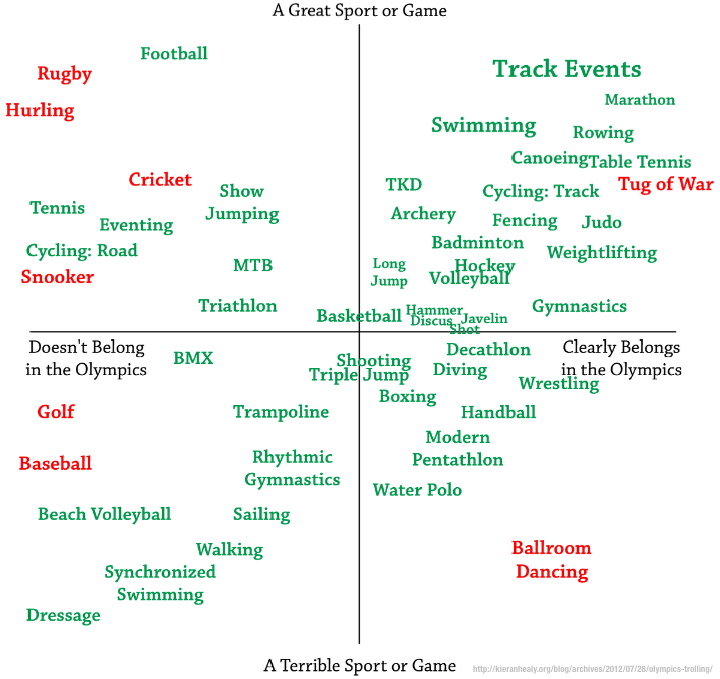Olympics Trolling
It’s that happy time when I whine about American television coverage of the Olympics. This year’s whining has a new twist—beyond the usual complaints about sentimental crap and tape-delay—because there are no decent streaming options absent a pre-existing subscription to some cable channels. But it’s also the time when I am reminded of my existing personal prejudices about sports, when I may discover new ones (as new events are added), and when I try to figure out whether there’s any defensible rationale to my preferences. A moment’s thought suggests that my views are perfectly correct. Reflecting a little further on my sports bigotry, I think the simplest model is a two-dimensional space that, I think you will agree, is both easy to understand and wholly objective.

The x-axis captures the intuition that some sports belong in the Olympics and some do not. The y-axis captures the intuition that some sports are terrific (not always for the same reasons) and some sports are terrible. Sports are plotted in this space, in a Bourdieuian fashion, according to their subjectively objective characteristics. Sports in green are already Olympic events, whether they deserve to be or not. Sports or activities in red are not Olympic events. I have separated out some sports (for clarity) and left others bundled (for convenience). For example, Eventing and Show Jumping are pretty good sports that nevertheless do not belong at the Olympics. Dressage, meanwhile, is a terrible sport that still doesn’t belong at the Olympics. Meanwhile, “Swimming” is clearly an Olympics-worthy sport, but the figure here leaves certain key questions about it unanswered, most obviously the preposterous number of events it contains (distances x strokes x medleys x individual/team) by comparison to track events.
In general, sports in the upper-left quadrant are those with international federations or true professional leagues of their own (Rugby), or are of high quality but strictly local interest (Hurling), together with a couple of semi-interesting sports that dilute the Olympic brand and really belong in the lower left corner except for the fact that I sort of like them (Mountain Biking).
Sports in the upper-right quadrant, meanwhile, are securely Olympian, by and large, although some of them are a little suspect (e.g., hammer, shot putt) whereas others (Tug-of-War) clearly meet quality and Olympishness criteria but are excluded for no good reason. Most of them are the sort of niche, perhaps borderline absurd events that you don’t think about at all for four years but then find yourself completely fascinated by when you accidentally catch the final on TV—e.g., rowing, weightlifting, table tennis, or archery. In many ways these are the purest Olympic sports.
The bottom right quadrant is the interesting space of successful failures—sports that seem to belong in the Olympics, and which ought to be excellent niche events, yet are not. They are the sporting equivalent of Calvin Trillin’s “New Yorker Trap”—the out-of-the-way, unassuming little restaurant in Brooklyn that no-one knows about, and which serves shitty food. As for the non-included cases in this quadrant, this is the sphere of technically correct failures—events like Ballroom Dancing, which seem to meet all the formal criteria for inclusion as Olympic events, but which must be excluded on the grounds that inclusion would just make everyone look ridiculous.
Finally, the lower left quadrant is the sphere of bad-faith success: class warfare sports (Dressage, Sailing), accidentally effective social movements (Trampoline), things that should have been eliminated back in the 1920s instead of Dueling (the Walk), and bullshit California weekend activities (beach volleyball, BMX, probably Ultimate Frisbee soon, and eventually Quidditch as well I imagine).
I trust that clears things up. All that remains is for you to agree with me, and enjoy the rest of the games.